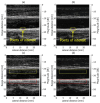Investigation of Ultrasound Transmit-Receive Sequence That Enables Both High-Frame-Rate Vascular Wall Velocity Estimation and High-Contrast B-Mode Images
- PMID: 40285129
- PMCID: PMC12031348
- DOI: 10.3390/s25082441
Investigation of Ultrasound Transmit-Receive Sequence That Enables Both High-Frame-Rate Vascular Wall Velocity Estimation and High-Contrast B-Mode Images
Abstract
In this study, we designed an ultrasound transmit-receive sequence to achieve high-frame-rate vascular wall velocity estimation and high-contrast B-mode imaging. The proposed sequence extends conventional dual-transmission schemes by incorporating a third transmission with 180° phase inversion, enabling harmonic imaging via the pulse inversion (PI) method. To mitigate the frame rate reduction caused by the additional transmission, the number of simultaneously transmitted focused beams was increased from two to four, resulting in a frame rate of 231 Hz. A two-dimensional phase-sensitive motion estimator was employed for motion estimation. In vitro experiments using a chicken thigh moving in two dimensions yielded RMSE values of 3% (vertical) and 16% (horizontal). In vivo experiments on a human carotid artery demonstrated that the PI method achieved a lumen-to-tissue contrast improvement of 0.96 dB and reduced artifacts. Velocity estimation of the posterior vascular wall showed generally robust performance. These findings suggest that the proposed method has strong potential to improve atherosclerosis diagnostics by combining artifact-suppressed imaging with accurate motion analysis.
Keywords: multi-line transmission; phase-sensitive motion estimator; pulse inversion; ultrasound.
Conflict of interest statement
The authors declare no conflicts of interest.
Figures











Similar articles
-
Motion-compensated frame rate up-conversion in carotid ultrasound images using optical flow and manifold learning.Turk Kardiyol Dern Ars. 2019 Dec;47(8):680-686. doi: 10.5543/tkda.2019.69776. Turk Kardiyol Dern Ars. 2019. PMID: 31802770 English.
-
Adaptive Ultrasound Tissue Harmonic Imaging Based on an Improved Ensemble Empirical Mode Decomposition Algorithm.Ultrason Imaging. 2020 Mar;42(2):57-73. doi: 10.1177/0161734619900147. Epub 2020 Jan 29. Ultrason Imaging. 2020. PMID: 31994455
-
Effects of parameters on the accuracy and precision of ultrasound-based local pulse wave velocity measurement: a simulation study.IEEE Trans Ultrason Ferroelectr Freq Control. 2014 Dec;61(12):2001-18. doi: 10.1109/TUFFC.2014.006597. IEEE Trans Ultrason Ferroelectr Freq Control. 2014. PMID: 25474776
-
Fast inter-frame motion correction in contrast-free ultrasound quantitative microvasculature imaging using deep learning.Sci Rep. 2024 Oct 30;14(1):26161. doi: 10.1038/s41598-024-77610-4. Sci Rep. 2024. PMID: 39478021 Free PMC article.
-
Lumen segmentation and motion estimation in B-mode and contrast-enhanced ultrasound images of the carotid artery in patients with atherosclerotic plaque.IEEE Trans Med Imaging. 2015 Apr;34(4):983-93. doi: 10.1109/TMI.2014.2372784. Epub 2014 Nov 21. IEEE Trans Med Imaging. 2015. PMID: 25423650
References
-
- Yamasaki Y., Kodama M., Nishizawa H., Sakamoto K., Matsuhisa M., Kajimoto Y., Kosugi K., Shimizu Y., Kawamori R., Hori M. Carotid intima-media thickness in Japanese type 2 diabetic subjects: Predictors of progression and relationship with incident coronary heart disease. Diab. Care. 2000;23:1310–1315. doi: 10.2337/diacare.23.9.1310. - DOI - PubMed
MeSH terms
Grants and funding
LinkOut - more resources
Full Text Sources
Research Materials
Miscellaneous

